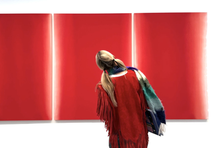Noguchi
- The Courtauldian
- Aug 10, 2023
- 3 min read
by Caroline Benedict | 10 November 2021

Noguchi exhibition, Barbican Art Gallery.
The Noguchi exhibition unfolding at the Barbican Art Gallery pays tribute to the Japanese American artist Isamu Noguchi (1904-1988), in a rather free and unconventional manner, where sculpture meets design, through a unique narrative. Spread across the two floors of the gallery, Noguchi’s stone and metal sculptures interact with his delicate, gleaming akari lamps (traditional Japanese lights made of bamboo frame and washi paper), in contrast with the dimly lit and sturdy brutalist environment of the Barbican. Noguchi’s art works are dispersed across the gallery space, employing the floors, walls and ceiling in a creative and playful manner. Upon entering the gallery, visitors are confronted with a large amount of free-standing pieces and akaris of various shapes arranged loosely across the room. As part of this less formal approach, the curator restrained from using any labels next to the art works, relying on the exhibition brochure to provide a cataloguing of all exhibited objects.
Noguchi’s oeuvre is marked not only by its interdisciplinary scope – including sculpture, performance and design – but also by the artist’s social and environmental consciousness. His humanistic vision materializes into his biomorphic sculptures, land art projects, anti-fascist murals, furniture pieces and diverse public projects. While some curators address artists’ entire careers by displaying their works in a strictly chronological manner, this retrospective organises Noguchi’s art works and design pieces around themes that reflect the artist’s various investigations and personal engagements. As a result, each of the rooms gathers works from different periods of the artist’s life in order to investigate the theme in question. Room number 5, Lunar, reflects Noguchi’s experiments with the integration of electrical components into his biomorphic sculptures, inspired by the barren landscape of the Arizona desert. During World War Two, Japanese citizens living in the Western United States were imprisoned in camps. Although a New York resident and therefore exempt, Noguchi decided to enter one of these camps in Poston, Arizona to show his support to fellow Japanese American citizens, and to help create an arts and recreation centre aimed at improving prisoners’ lives. Room number nine, Earth, gathers pieces and projects that address humanity’s relation to the earth. It showcases Noguchi’s ceramics of the 1950s inspired by traditional Japanese craft and stone sculptures that seem to emerge from the earth. His land art projects such as Sculpture to be Seen from Mars of 1947 reflect on the devastation of our post-atomic world.
When commenting on his film Frontier of 1935, Noguchi explained that he ‘[…] thought of space as a volume to be treated sculpturally’. [1] It seems that the Noguchi exhibition similarly creates sculptural spaces consistent with the artist’s vision, in a creative and unconventional manner. Room number six, Landscape of the Mind, only contains three objects. Two heavy and solid travertine and marble sculptures, Double Red Mountain (1969) and Time Lock (1944-1945), stand firmly on the floor, whilst a massive yet fragile spherical lamp, Akari 120A (c.1956 / c.1963), hangs from the ceiling. This set up creates a harmonious environment evocative of minimalist Japanese gardens. The choice of display in Noguchi is striking to the visitor and it deliberately directs attention towards the play of space and light as much as to the exhibited art works themselves. The multiplicity of akari lamps and design pieces placed in the gallery create an immersive experience of space. Their inclusion hints at Noguchi’s desire to dissolve the barriers between fine art, traditional craft and technology, whilst the presence of quotes from the artist throughout the exhibition underscores the curator’s intention to immerge visitors further into the narrative. Light is used in a playful manner that balances the dim and austere environment of the Barbican Art Gallery. This is achieved by the akaris in the room which create their own, endearing narratives. Under the staircase of the lower gallery, a group of little Akari VB 13-T lamps seem to move forward as if taking part in a procession. The set up engages with Noguchi’s main artistic commitments, unveiling his attempt to ‘break out of the categories of sculpture’ and to make public art more accessible, through an empathic interpretation of nature. [2] [1] Barbican Art Gallery, Noguchi, cur. Florence Ostende, exhibition brochure, Barbican (London, 2021), p.2. [2] Barbican Art Gallery, Noguchi, p. 2.












Comments